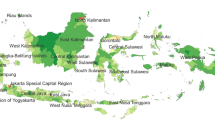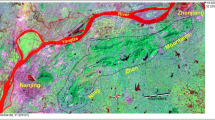Abstract
The Three-North Shelter Forest Program is the largest afforestation reconstruction project in the world. Remote sensing is a crucial tool to map land use and land cover change, but it is still challenging to accurately quantify the change in forest extent from time-series satellite images. In this paper, 30 Landsat MSS/TM/ETM+ epochs from 1974 to 2012 were collected, and the high-quality ground surface reflectance (GSR) time-series images were processed by integrating the 6S atmosphere transfer model and a relative reflectance normalization algorithm. Subsequently, we developed a vegetation change tracking method to reconstruct the forest change history (afforestation and deforestation) from the time-series Landsat GSR images based on the integrated forest z-score (IFZ) model by Huang et al. (2009a), which was improved by multi-phenological IFZ models and the smoothing processing of IFZ data for afforestation mapping. The mapping result showed a large increase in the extent of forest, from 380,394 ha (14.8 % of total district area) in 1974 to 1,128,380 ha (43.9 %) in 2010. Finally, the land cover and forest change map was validated with an overall accuracy of 89.1 % and a kappa coefficient of 0.858. The forest change time was also successfully retrieved, with 22.2 % and 86.5 % of the change pixels attributed to the correct epoch and within three epochs, respectively. The results confirmed a great achievement of the ecological revegetation projects in Yulin district over the last 40 years and also illustrated the potential of the time-series of Landsat images for detecting forest changes and estimating tree age for the artificial forest in a semi-arid zone strongly influenced by human activities.








Similar content being viewed by others
References
Brandt, J. S., Kuemmerle, T., Li, H., Ren, G., Zhu, J., & Radeloff, V. C. (2012). Using Landsat imagery to map forest change in southwest China in response to the national logging ban and ecotourism development. Remote Sensing of Environment, 121, 358–369.
Caccetta, P., Furby, S., O’Connell, J., Wallace, J., & Wu, X. (2007). Continental monitoring: 34 years of land cover change using Landsat imagery. In, 32nd International Symposium on Remote Sensing of Environment (pp. 25–29)
Caccetta, P.A., Furby, S., Wallace J., Wu, X., Richards, G. and Waterworth, R. (2013). Long-Term monitoring of the Australian land cover change using Landsat data: Development, implementation and operation, in Global Forest Monitoring from Earth Observation, Achard and Hansen (editors), Boca Raton, FL, CRC press. ISBN 978-1-4665-5201-2
Chander, G., Markham, B. L., & Helder, D. L. (2009). Summary of current radiometric calibration coefficients for Landsat MSS, TM, ETM+, and EO-1 ALI sensors. Remote Sensing of Environment, 113, 893–903.
Chapin Iii, F. S., Zavaleta, E. S., Eviner, V. T., Naylor, R. L., Vitousek, P. M., Reynolds, H. L., et al. (2000). Consequences of changing biodiversity. Nature, 405, 234–242.
Cohen, W. B., Maiersperger, T. K., Gower, S. T., & Turner, D. P. (2003). An improved strategy for regression of biophysical variables and Landsat ETM+ data. Remote Sensing of Environment, 84, 561–571.
Duan, H., Yan, C., Tsunekawa, A., Song, X., Li, S., & Xie, J. (2011). Assessing vegetation dynamics in the Three-North Shelter Forest region of China using AVHRR NDVI data. Environmental Earth Sciences, 64, 1011–1020.
Foley, J. A., DeFries, R., Asner, G. P., Barford, C., Bonan, G., Carpenter, S. R., et al. (2005). Global consequences of land use. Science, 309, 570–574.
Goward, S. N., & Williams, D. L. (1997). Landsat and earth systems science: Development of terrestrial monitoring. Photogrammetric Engineering and Remote Sensing, 63, 887–900.
Goward, S. N., Masek, J. G., Cohen, W., Moisen, G., Collatz, G. J., Healey, S., et al. (2008). Forest disturbance and North American carbon flux. Eos, Transactions of the American Geophysical Union, 89, 105–116.
Hirsch, A. I., Little, W. S., Houghton, R. A., Scott, N. A., & White, J. D. (2004). The net carbon flux due to deforestation and forest re-growth in the Brazilian Amazon: Analysis using a process-based model. Global Change Biology, 10, 908–924.
Huang, C., Goward, S. N., Schleeweis, K., Thomas, N., Masek, J. G., & Zhu, Z. (2009a). Dynamics of national forests assessed using the Landsat record: Case studies in eastern United States. Remote Sensing of Environment, 113, 1430–1442.
Huang, C., et al. (2009b). Development of time series stacks of Landsat images for reconstructing forest disturbance history. International Journal of Digital Earth, 2, 195–218.
Huang, C., et al. (2010). An automated approach for reconstructing recent forest disturbance history using dense Landsat time series stacks. Remote Sensing of Environment, 114, 183–198.
Law, B. E., Turner, D., Campbell, J., Sun, O. J., Van Tuyl, S., Ritts, W. D., et al. (2004). Disturbance and climate effects on carbon stocks and fluxes across Western Oregon USA. Global Change Biology, 10, 1429–1444.
Lehmann, E. A., Wallace, J. F., Caccetta, P. A., Furby, S. L., & Zdunic, K. (2013). Forest cover trends from time series Landsat data for the Australian continent. International Journal of Applied Earth Observation and Geoinformation, 21, 453–462.
Li, M., Huang, C., Zhu, Z., Shi, H., Lu, H., & Peng, S. (2009a). Assessing rates of forest change and fragmentation in Alabama, USA, using the vegetation change tracker model. Forest Ecology and Management, 257, 1480–1488.
Li, M., Huang, C., Zhu, Z., Wen, W., Xu, D., & Liu, A. (2009b). Use of remote sensing coupled with a vegetation change tracker model to assess rates of forest change and fragmentation in Mississippi, USA. International Journal of Remote Sensing, 30, 6559–6574.
Liu, L., Jing, X., Wang, J., & Zhao, C. (2009). Analysis of the changes of vegetation coverage of western Beijing mountainous areas using remote sensing and GIS. Environmental Monitoring and Assessment, 153, 339–349.
Pang, G., Dong, X., Song, X., Li, B., & Ma, R. (2012). Remote sensing monitoring of forest land change in Hexi corridor since construction of the Three-North Shelterbelt Project. Journal of Desert Research, 32, 037–042.
Savitzky, A., & Golay, M. J. E. (1964). Smoothing and differentiation of data by simplified least squares procedures. Analytical Chemistry, 36, 1627–1639.
Schimel, D. S., Participants, V., & Braswell, B. H. (1997). Continental scale variability in ecosystem processes: Models, data, and the role of disturbance. Ecological Monographs, 67, 251–271.
Shumway, R. H. (1987). Statistics and data analysis in geology. Technometrics, 29, 492–492.
State Forestry Administration, P. R. C. (2008). 30 years development report of the Three-North Shelter Forest system construction. Beijing: China Forestry Publishing House.
Teillet, P., Guindon, B., & Goodenough, D. (1982). On the slope-aspect correction of multispectral scanner data. Canadian Journal of Remote Sensing, 8, 84–106.
Thornton, P. E., Law, B. E., Gholz, H. L., Clark, K. L., Falge, E., Ellsworth, D. S., et al. (2002). Modeling and measuring the effects of disturbance history and climate on carbon and water budgets in evergreen needleleaf forests. Agricultural and Forest Meteorology, 113, 185–222.
Townshend, J. R., Masek, J. G., Huang, C., Vermote, E. F., Gao, F., Channan, S., et al. (2012). Global characterization and monitoring of forest cover using Landsat data: Opportunities and challenges. International Journal of Digital Earth, 5, 373–397.
Vermote, E. F., El Saleous, N. Z., & Justice, C. O. (2002). Atmospheric correction of MODIS data in the visible to middle infrared: First results. Remote Sensing of Environment, 83, 97–111.
Vitousek, P. M., Mooney, H. A., Lubchenco, J., & Melillo, J. M. (1997). Human domination of earth’s ecosystems. Science, 277, 494–499.
Wang, X. M., Zhang, C. X., Hasi, E., & Dong, Z. B. (2010). Has the Three North Forest Shelterbelt Program solved the desertification and dust storm problems in arid and semiarid China? Journal of Arid Environments, 74, 13–22.
Wang, Q., Zhang, B., Dai, S., Zou, Y., Ma, Z., & Zhang, Y. (2011). Dynamic changes in vegetation coverage in the Three-North Shelter Forest Program based on GIMMS AVHRR NDVI. Resources Science, 8, 1613–1620.
Waring, R. H., & Running, S. W. (2007). Forest ecosystems: Analysis at multiple scales. San Diego: Academic Press.
Williams, D. L., Goward, S., & Arvidson, T. (2006). Landsat: Yesterday, today, and tomorrow. Photogrammetric Engineering and Remote Sensing, 72, 1171–1178.
Woodcock, C. E., Allen, R., Anderson, M., Belward, A., Bindschadler, R., Cohen, W., et al. (2008). Free access to Landsat imagery. Science, 320, 1011–1013.
Wu, X., Furby, S., & Wallace, J. (2004). An approach for terrain illumination correction. In, The 12th Australasian Remote Sensing and Photogrammetry conference proceedings, Fremantle, Western Australia (pp. 18–22)
Wu, Y., Zeng, Y., Wu, B., Li, X., & Wu, W. (2009). Retrieval and analysis of vegetation cover in the Three-North Regions of China based on MODIS data. Chinese Journal of Ecology, 28, 1717–1718.
Yan, Q., Zhu, J., Hu, Z., & Sun, O. (2011). Environmental impacts of the shelter forests in Horqin Sandy Land, northeast China. Journal of Environmental Quality, 40, 815–824.
Zha, Y., Liu, Y., & Deng, X. (2007). A landscape approach to quantifying land cover changes in Yulin, Northwest China. Environmental Monitoring and Assessment, 138, 139–147.
Zhu, Z., Woodcock, C. E., & Olofsson, P. (2012). Continuous monitoring of forest disturbance using all available Landsat imagery. Remote Sensing of Environment, 122, 75–91.
Acknowledgments
The authors gratefully acknowledge financial support provided for this research by the External Cooperation Program of the Chinese Academy of Sciences (GJH21123) and the National Natural Science Foundation of China (41222008, 91125003).
Author information
Authors and Affiliations
Corresponding author
Rights and permissions
About this article
Cite this article
Liu, L., Tang, H., Caccetta, P. et al. Mapping afforestation and deforestation from 1974 to 2012 using Landsat time-series stacks in Yulin District, a key region of the Three-North Shelter region, China. Environ Monit Assess 185, 9949–9965 (2013). https://doi.org/10.1007/s10661-013-3304-2
Received:
Accepted:
Published:
Issue Date:
DOI: https://doi.org/10.1007/s10661-013-3304-2




